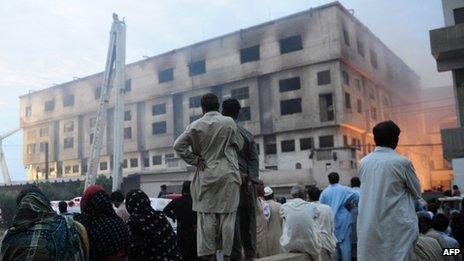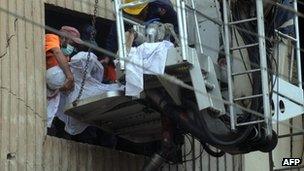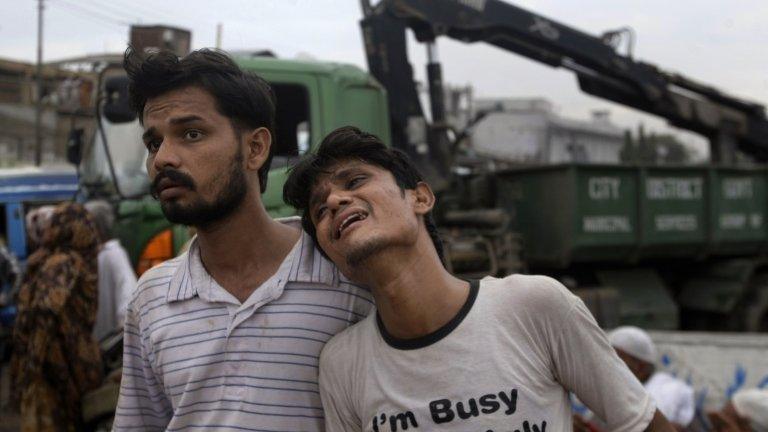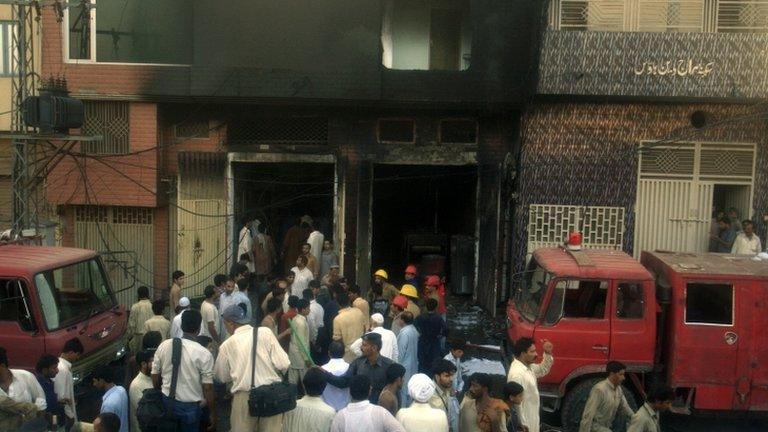Deadly Karachi blaze was 'waiting to happen'
- Published

For many the fire was a disaster that was waiting to happen
It was during the late afternoon shift change when the fire which has so far killed nearly 300 people broke out at the garments factory in Karachi.
Survivors say the power was the first thing to go after the blast which preceded the blaze in Pakistan's commercial capital.
"There was an immediate scramble for the exit - leading to chaos," a survivor told the BBC.
"People piled on top of each other - some got crushed as there was just one way out and so many people.
"Everybody was screaming and pushing - it was pure panic and fear. I thought I was going to die."
Death trap
Those who could not get out tried breaking through the iron-barred windows at the Ali Enterprises factory.

A common denominator is the lack of adequate safety standards
For many, fear of imminent death put paid to any misgivings about jumping 6m (20ft) to escape - leading to many broken bones.
But these were the lucky ones - those still trapped inside were faced with a horrific choice: suffocation or incineration.
Rescue workers had by that time started arriving on the scene.
They were able to get dozens of people out of the front of the building. Local residents and relatives of those inside also arrived to help.
Their numbers grew so big that at one point they hampered the rescue effort. Police had to stop distraught relatives from going into the factory - by now a death trap - in search of their loved ones.
Brothers and sons, sisters and wives were seen urging rescue workers to do more, while simultaneously trying to venture into the premises themselves.
This led to some ugly altercations - until more security personnel arrived and brought the crowd under control.
Meanwhile, the fire had become a raging inferno, dwarfing the cries of workers trapped in the factory.
Rescue problems

The rescue operation was temporarily hampered by large crowds outside the factory
Later Karachi's fire chief admitted to reporters that the rescue effort had been hampered by a lack of resources.
At one point the fire engines ran out of water.
Fire fighting equipment in general appears to have been minimal at the factory - fire exits had not been built or were shut to make space for storage.
Training the staff was probably never a consideration - although it remains part of Pakistan's industrial safety laws.
Eventually, the navy's fire fighting team was called in - but by then it was too late for most of those trapped in the building.
Karachi fire chief Ehtesham Salim later told journalists that aerial water spraying may have helped and the authorities had at one point considered calling in the air force.
Ironically it had been raining in Karachi for a week - the only exception being on the evening the inferno broke out.
Although the fire was brought under control on Wednesday, late into the evening rescue workers were still digging through the debris of the building for bodies and any survivors.
The structure itself is near collapse - the debris being slowly excavated to make sure those still inside are not crushed.
The source of the fire is thought to have been a faulty electrical switch. A case has been registered against the owner - and police officials say they have launched an investigation.
But it is clear to those who have seen such disasters in the past that the sheer human cost in this blaze was not just the result of an accident.
For many it was years in the making - and possibly the biggest industrial fire in Pakistan's history.
The Hub river massacre - as people are now calling the garment factory blaze - dwarfs others in scale, but the circumstances of the fire have unfortunately been replayed across Pakistan often of late.
In this case the factory was a recipe for tragedy - its low-ceiling halls were crammed with machines manned by workers toiling away in sweat shop conditions to produce top-of-the-line, ready-to-wear garments which earned the factory owners millions of dollars annually.
The workers, on the other hand, go home with $5 to $6 a day. There are no other benefits.
As the factory's profits turned to ashes, Karachi's Civil Hospital was besieged by hundreds of grieving relatives desperately searching for their loved ones among dozens of bodies, many burnt beyond recognition.
Lethal combination
In the commercial sector it is not just textile mills - industries across Pakistan are more prone than ever to disasters, many here feel.
Although fires cause the main damage, it is not unknown for poorly constructed premises to collapse on top of workers or residents.
In general, the problem is the same that plagues all matters of governance in Pakistan - a failure to enforce the law. Whether it is an industrial disaster, a road accident or an air crash - the common denominator is the lack of adequate safety checks.
Textile factories are particularly at risk due to the lethal combination of chemical dyes and stacks of cotton often stored next to each other - ensuring a deadly result.
Fire exits - as in the case of the factory in Karachi - exist only on paper.
That - along with the congested construction of the industrial zones - prevents escape and multiplies the death toll.
The city administration itself has a limited number of fire engines to serve the growing needs of the sprawling metropolis.
Lahore fares a little better in terms of equipment but is no better in terms of enforcement of standards or disaster management.
Observers see a common pattern. Industrial standards are disregarded to minimise cost as inspectors are paid to look the other way.
Small and potentially easily rectifiable problems are made worse by years of official neglect. Mistakes are covered up only to be repeated a few months later.
That is why many fear disasters such as the Karachi fire are on the rise in Pakistan.
- Published12 September 2012

- Published11 September 2012

- Published15 March 2024
